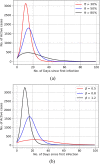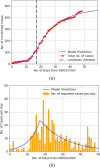Predicting the Spread of COVID-19 Using Model Augmented to Incorporate Quarantine and Testing
- PMID: 38624542
- PMCID: PMC7380501
- DOI: 10.1007/s41403-020-00151-5
Predicting the Spread of COVID-19 Using Model Augmented to Incorporate Quarantine and Testing
Abstract
India imposed a nationwide lockdown from 25th March 2020 onwards to combat the spread of COVID-19 pandemic. To model the spread of a disease and to predict its future course, epidemiologists make use of compartmental models such as the model. In order to address some of the assumptions of the standard model, a new modified version of model is proposed in this paper that takes into account the percentage of infected individuals who are tested and quarantined. This approach helps overcome the assumption of homogenous mixing of population which is inherent to the conventional model. Using the available data of the number of COVID-19 positive cases reported in the state of Kerala, and in India till 26th April, 2020 and 12th May 2020, respectively, the parameter estimation problem is converted into an optimization problem with the help of a least squared cost function. The optimization problem is then solved using differential evolution optimizer. The impact of lockdown is quantified by comparing the rising trend in infections before and during the lockdown. Using the estimated set of parameters, the model predicts that in the state of Kerala, by using certain interventions the pandemic can be successfully controlled latest by the first week of July, whereas the value for India is still greater than 1, and hence lifting of lockdown from all regions of the country is not advisable.
Keywords: COVID-19; India; Kerala; Pandemic; Quarantine; SIR Model; Testing.
© Indian National Academy of Engineering 2020.
Figures










References
-
- Adamu HA, Murtala M, Abdullahi MJ, Mahmud AU (2019) Mathematical modelling using improved SIR model with more realistic assumptions. Int J Eng Appl Sci. 10.31873/IJEAS.6.1.22
-
- Aravind LR et al (2020) epidemic landscape and forecasting of SARS-CoV-2 in India. Preprint at https://www.medrxiv.org/content/10.1101/2020.04.14.20065151v1 - DOI - PMC - PubMed
-
- Crowdsourced India COVID-19 tracker data. https://bit.ly/patientdb
-
- Lopez L, Roda X (2020) A Modified SEIR model to predict COVID-19 outbreak in Spain and Italy: simulating control scenarios and multi scale epidemics. Preprint at https://www.medrxiv.org/content/10.1101/2020.03.27.20045005v3 - DOI - PMC - PubMed
LinkOut - more resources
Full Text Sources
Miscellaneous
